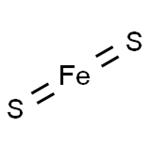Uses
For grain mounts, XRD and microprobe standards, identification of unknown minerals.Pyrite is used in the preparation of iron(II) sulfate, sulfur dioxide and iron(II) sulfide. It finds application as semiconductor material, as the cathode material in energizer band and non-rechargeable lithium batteries. It is utilized to make marcasite jewelry. In addition, it is used in photovoltaic solar panels. It is useful for grain mounts, XRD and microprobe standards and identification of unknown minerals.
Agricultural Uses
Pyrite or iron pyrite (FeS
2) is a mineral containing iron
and sulphur, and occurs in igneous and metamorphic
rocks. It is also found in sedimentary deposits. Pyrite
resembles gold in appearance and hence it is also known
as fool's gold. It is harder than gold, the hardness being 6
to 6.5 on the Mohs' scale. It is the most common and
widespread of the sulphide minerals and is used as a
source of sulphur for the production of sulphuric acid
(H
2SO
4). Under oxidizing conditions, pyrite readily
alters to iron sulphates and eventually to limonite,
forming gossans, the surface expression for pyrite-rich
mineral deposits.
Soils with excess pyrite become strongly acidic for
cultivation. When drained and aerated enough for
cultivation, these soils are termed acid sulphate soils or
Katteklei (cat clays) in Dutch.
The role of sulphur in pyrites is multidimensional.
Iron pyrite is a potential source of sulphur for correcting
sulphur-deficiency in crops raised on alkaline, calcareous
soils. Iron pyrite prevents iron chlorosis in plants and
possibly leads to an improvement in the availability of
other nutrients such as P, Fe, Mn and Zn. This is because
pyrite not only contains these micronutrients as
impurities but also enhances the availability of these
native forms by increasing acidity. This role of pyrite is
of special significance in calcareous soils where lime-induced
chlorosis is very common in many crops.
Pyrite can be applied at the rate of 250 kg/ha to
correct lime-induced chlorosis, to improve the malleable
cane percentage and the yield of sugar cane on calcareous
soil.
A symbiotic nitrogen fixation has a special
significance in improving soil fertility. Using graded
doses of pyrite (0 to 400 kg/ha), the number and dry
weight of nodules, as well as grain and straw yield of
chickpea increase significantly.
Agricultural Uses
Iron pyrite, also called fool's gold because of its superficial resemblance to gold, is a brassy-yellow or brown tarnished mineral with metallic luster. It is iron disulphide, crystallizing in the cubic system, occurring in octahedral, pyritohedra, etc. Iron pyrite is used in the manufacture of sulphur, sulphuric acid, sulphur dioxide, ferrous sulphate and cheap jewelry.



